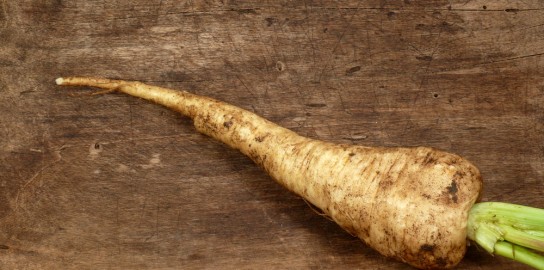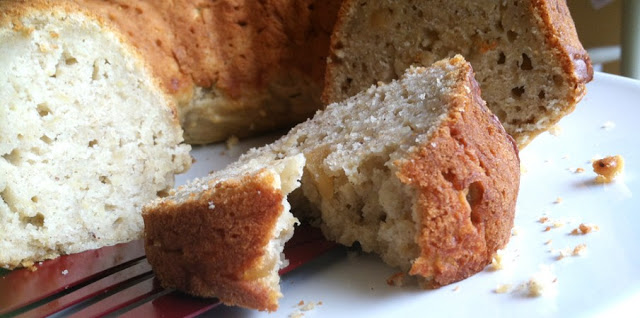Real Food Right Now and How to Cook It: Parsnips
If you cooked and ate solely based on the first impressions of others, you might never let a parsnip pass your lips. An online search yields the kind of reviews guaranteed to make aspiring parsnip eaters run in the opposite direction. Here’s a just a small sample of the bad press:
“About as exciting as it is colorful.”
“Looks like an anemic carrot.”
“Evoke[s] memories of school cafeterias and Dickensian images of orphanages.”
Even among the cheerleading minority, the parsnip tends to be praised conditionally and with restraint.
Says Brit food writer Nigel Slater in his book Tender: “I haven’t always loved the parsnip,” further explaining it took until later in life for him to warm up to the homely root vegetable.
The late great food doyenne Jane Grigson, an unapologetic parsnip fan, writes in her Vegetables book: “Never serve them straight from the water, any more than you would appear at the dinner table dripping from the bath. Only asparagus and Aphrodite can get away with it.”
Despite her disappointment that the parsnip is a “valuable vegetable that is perennially ignored,” produce scholar Elizabeth Schneider acknowledges its “fairly frumpy and pallid” appearance in her tome, Vegetables from Amaranth to Zucchini.
And yet, in these final weeks leading up to the vernal equinox, seasonal produce pickings are, frankly, slim, which means the parsnip (and its underground brethren) are what’s on the menu. Best we stop listening to the parsnip punditry, live in the produce moment and find out what the ‘snip is all about.
A Brief History
The story is that the wild parsnip probably hails from the southern part of Europe, around the Mediterranean, and most likely cultivated since Roman times.
Roman scholar Pliny the Elder refers to pastinaca in his Naturalis Historia in first century AD, but many historians claim that he was referring to both the parsnip and its more pigmented cousin, the carrot. Around the same time, Roman gastronome Apicius included recipes for parsnips in his cookbook De Re Coquinaria.
From there the root migrated north and found its way into the medieval gardens of France, Britain and Germany. In his book Cabbages and Kings, culinary scholar Jonathan Roberts notes that Charlemagne insisted that parsnips be grown on his 9th century estate. U ntil the potato arrived from the New World, the parsnip was the apparent root of choice in medieval Europe, providing both humans and their livestock starchy sustenance (parsnips still have a reputation as animal feed) and it was a sweet alternative to honey, which was scarce. Easily fermented, the parsnip was made into both beer and wine, a practice that continued on the other side of the Atlantic well into the 19th century.
Factual Nibbles
Before the parsnip made its way to colonial America, it stopped off in the West Indies, which was too hot for the cold-loving root. First colonial stop was Virginia, then it migrated further north to Massachusetts and was revered by native American tribes.
In his cookbook 50 Chowders, Boston-area chef Jasper White writes that “Westfield, Massachusetts is to parsnips what Castroville California is to artichokes (i.e. America’s capital).” Unfortunately, we can’t find any supporting evidence to this claim, but western Massachusetts is potato country, so we’ll take the chef’s word for it.
Cultivation
Botanically known as Pastinaca sativa, the parsnip is part of the larger Umbelliferae family, which includes carrots, chervil, parsley, fennel, celeriac and celery. If you think about it, all of these plants have a similar, herbaceous yet slightly sweet aroma.
Etymologically, the word pastinaca comes from the Latin word pastinare, which means ‘that which is dug up’ (the French word is pasnaie; in Russian, it’s pasternak) and the “nip” suffix is derived from naep, an Old English word for turnip which comes from the Latin napus.
Environmental Impact/Seasonality
Because it’s not grown on a massive scale, the parsnip is excluded from the Environmental Working Group Shopper’s Guide to Pesticides in Produce. Depending on where you live, you may find it in your supermarket produce aisle, but more likely at the farmers’ market. The parsnip is a great example of seasonal, local produce that is truly at its peak during the coldest months of the year. Buying parsnips (or anything else) from local farmers presents a great opportunity to ask growers about production methods as well as recipes and favorite ways to prepare. For two-thirds of the country, you’ll see parsnips until the early weeks of spring. (See our veggie rule of thumb*.)
Characteristics
The stories are true – the parsnip does look an albino carrot, usually a shade of pale yellow, ivory or off-white. Contrary to popular belief, the parsnip is not a genetic mutation of the carrot, but the two are botanically related. The parsnip tends to have a thinner tip and typically is sold without its green tops, which can irritate the skin. In the course of my research, both the words “spindle” and “dibble” made frequent appearances to describe its physical characteristics.
As sweet as the carrot is, the parsnip is even sweeter. In fact, a frost will intensify its sugar content and residual sweetness. Vegetable gardeners claim that the parsnip is one of the few root vegetables that happily stays underground to “winter over,” a nifty tip for those gardeners with limited indoor storage space.
Nutrition
The parsnip can do your body good. One cup of raw parsnips contains six grams of fiber, at 100 calories. It’s rich in potassium and a respectable source of calcium, iron, Vitamin C and folate. It is being studied for its cancer-fighting properties, which come from a phytochemical called falcarinol.
What to Look for
The perfect ‘snip sounds like a bit like something out of Goldlilocks: Firm but not woody, and definitely not too soft. One should not be able to bend a ‘snip.
What to Do with It
Nigel Slater insists that “to get the best out of this vegetable, you need to caramelize the sugars present in the flesh and introduce an element of richness with butter, cream or spices. There is little excitement in a plainly boiled root.”
Storage
Remember, this is a hardy vegetable suitable for storage, so long as you keep it dry. Wrap in a towel or perforated bag, and your ‘snips should keep for a few weeks. Wash and peel just before cooking.
Cooking Tips
Roasting coaxes the nuttiness out of parsnips, but I agree with other cooks that a quick parboil is a good idea, to help soften the starch. Before coating in fat for roasting (or sautéing), be sure to towel dry the parboiled parsnips or you’ll end up with steamed parsnips instead.
The next time you’re making mashed potatoes, add one or two quartered parsnips to the mix, along with a whole clove of garlic. You’ll end up with a mash that’s a little bit earthier, with a hint of sweetness and a whole bunch more nutrients.
The ‘snip likes warm spices – ginger, nutmeg, cinnamon, curry, cardamom (as you’ll see in the recipe below), and likes sugar in all forms, from maple syrup to the granulated stuff.
I love the idea of poaching parsnips in coconut milk from The Organic Cook’s Bible by Jeff Cox: “Poach quartered roots in barely simmering coconut milk until almost tender, then finish by sautéing them in a little butter with a pinch of salt, and at the end add a splash of coconut milk from the poaching liquid and reduce it until it glazes the roots.”
On my to-do list is a recipe from Diane Morgan’s new cookbook, Roots, in which she suggests adding sautéed diced parsnips to spaghetti carbonara for a twist on an old classic. Instead of peas, I might add a bunch of chopped fresh parsley to the mix.
Morgan also has a recipe for a triple layer parsnip cake, an idea that might seem peculiar on first blush. But as mentioned earlier, parsnips are even sweeter than carrots, which make it into baked goods all the time. Why not parsnips in the bakery case?
Inspired by this notion, I came up with my own version, a single-layer coffee cake made in a Bundt-style pan. Spiced up with cardamom, cinnamon and candied ginger, and further sweetened with apples, this homey cake is a revelation that just might change your tune about ‘snips, vegetables in dessert and who knows what else.
Recipe
Parsnip-Apple-Cardamom Coffee Cake
Ingredients
2 to 3 medium-size parsnips, cleaned, peeled and root removed
2 medium-size crisp apples of choice, peeled, cored and quartered
3 cups all-purpose flour
1 tablespoon baking powder
2 teaspoons ground cardamom
2 teaspoons ground cinnamon
¼ ; teaspoon salt
¼ ; cup candied ginger, chopped finely
¾ ; cup neutral oil (grapeseed, safflower, rice bran)
1 cup granulated sugar
3 large eggs
½ ; cup milk (or unsweetened non-dairy alternative; I used fortified coconut milk with success)
Thoroughly grease a 9 or 10-inch Bundt-style cake pan. (This is also known as a tube pan.) Preheat the oven to 375 degrees.
Using a box grater or a food processor with a shredding blade, shred or finely grate the parsnips and apples. You’re looking for 2 cups of grated parsnips and 1 cup of grated apples. Combine and set aside.
In a medium-size bowl, place the flour, baking powder, cardamom, cinnamon, salt and candied ginger.
In a large bowl, place the oil and the sugar and “cream” with a handheld electric beater until well integrated and somewhat creamy, about 3 minutes. Add eggs, one at a time, until mixture is light yellow and color and somewhat fluffy, about 2 minutes.
Fold one-third of dry ingredients into the egg-sugar-oil mixture, alternating with half of the milk, beating with each addition. Using a wooden spoon or rubber spatula, stir in the parsnips and apples, until well integrated.
Transfer the batter into the prepared cake pan, and place the pan on a baking tray. Bake the cake for about 50 minutes, or until a skewer inserted in the cake comes out clean.
Transfer the cake to a baking rack and allow to cool for about 20 minutes before inverting onto a plate. Allow to completely cool before serving.
Makes 12-14 servings.
(*Fruit and vegetable rule of thumb: We think that first and foremost, in terms of nutrition, people should eat lots of fruits and vegetables whether they are organic or not. The EWG’s guide is a handy list, but we will point out here that the impacts of pesticides are not limited to your ingestion of them – agricultural chemicals also affect farmworkers and local waterways, both good reasons to buy organic, even those vegetables that carry a light pesticide load. Also, it has been demonstrated that produce grown by small-scale farmers, even those who are not certified organic, tends to have a lighter pesticide load than its industrially-produced counterpart, owing to industry’s tendency toward large monocrops.)

